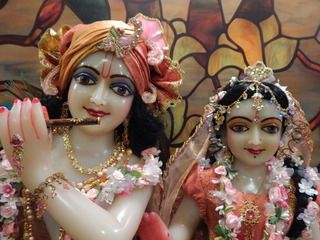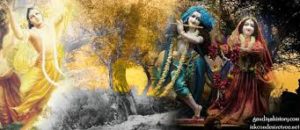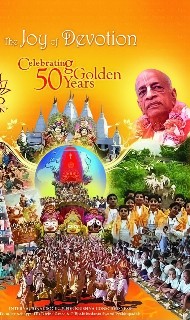What is a “Gāyatrī”?
The Veda is mostly poetry, meant to be sung. Chandaḥ — the metrics of poetic rhythm — is therefore one of the six essential subjects of traditional Vedic study, vedāṅga. Gāyatrī is a poetic-meter that has 24 syllables in total, divided into three lines with eight syllables in each.
The word gāyatrī is very similar to the word mantra. Mantra means “the tool (-tra) by which the mind (man-)”[i] can be saved (trayate).” Gāyatrī means, “the tool (-tra) by which a song (gāya-) can rescue us.”[ii]
What is “the Gāyatrī”?
There are a plethora of “gāyatrī mantra.” The most famous is Ṛg 3.62.10. It is so famous that saying, “gāyatrī” is practically the same as saying, “Ṛg 3.62.10.” This particular gāyatrī can also be addressed more directly and explicitly as the brahma gāyatrī – signifying that it represents the essence of all Vedic wisdom (brahma), or as the sāvitrī gāyatrī – signifying that it describes the ultimate origin of life and creation (savitṛ), or as sārasvatī gāyatrī, because the mantra is the epitome of verbal communication (sārasatī / vāk) and is therefore integral to the Vedic educational process, blessed by the Goddess of Learning (sarasvatī).
Agni Purāṇa (216.1-2):
It is called Gāyatrī because it sings (gāyati) about mantra, consciousness, perception, and the supreme. It is called Sāvitrī because it reveals the ultimate life-giver (savitā). It is called Sārasvatī because it is the essence of all words.
This gāyatrī is:
tat savitur vareṇiyaṁ
bharga devasya dhīmahī
dhiyo yo naḥ prachodayat
You may notice that I have spelled the third word on the first line vareṇiyaṁ (giving it four syllables), although it is often spelled vareṇyam (with three syllables). The spelling I use fulfills the rule of gātatrī having eight syllables per line.[iii]
When used as mantra — a tool for thought, contemplation, and meditation — Vedic statements are prefixed by a sacred syllable. Taittiriya Aranyaka (2.11.1-8) specifies the prefixes to use for this particular gāyatrī: the sacred syllable auṁ, followed by three vyāhṛti (invocational words): bhur, bhuvaḥ, and svaḥ.
The complete form of this gāyatrī, used as a mantra, is therefore:
auṁ
bhur bhuvaḥ svaḥ
tat savitur vareṇiyaṁ
bharga devasya dhīmahī
dhiyo yo naḥ pracodayat
Uses of Gāyatrī
Historically, India used gāyatrī primarily in the upayana ceremony initiating a student into study of the Vedas. It was used by the student for a meditation done three times a day, at sunrise, noon, and sunset.[iv] Since brāḥmanas undergo the most extensive education, gāyatrī has come to be a mantra associated with that caste, but originally everyone who received formal education (which includes kṣatriya, vaiṣya, and some śūdra) received the mantra in the upayana ceremony at their commencement. Similarly it has also come to be a mantra associated with men, but was originally given to both men and women at the beginning of their education. Defense of these points is outside the scope of this article about the meaning of gāyatrī, but for further exploration of these points please explore my references.[v]
Gauḍīya Vaiṣṇava’s did not use the mantra as part of their sādhana until relatively modern times, when visionary Bhaktisiddhānta Sarasvatī (1874 – 1937) introduced it in the dīkṣā ceremony, probably as part of his effort to impress upon the public that Vaiṣṇavas are automatically as good as brāḥmanas. Instead, they used the kāma-gāyatrī – a different gāyatrī with the same meter and structure as brahma-gāyatrī, but specifically dedicated to meditation upon Bhagavān as the original erotic principle, Kāmadeva. This is why Gauḍīya lineages not connected to Bhaktisiddhānta’s Gauḍīya Maṭha do not meditate on brahma-gāyatrī as part of their bhakti-sādhana, nor is the brahma-gāyatrī included in Gauḍīya meditation handbooks (smaraṇa-paddhati). Instead the kāma-gāyatrī is prominent, and has prominent explanations by important Gauḍīya ācāryas like Prabhodānanda Sārasvatī (Kāma-Gāyatrī-Vyākhyā) and Visvanātha Cakravarti (Mantrārtha-Dīpikā).
Although the Gauḍīyas did not use brahma-gāyatī they did respect the mantra immensely. In the founding document of the Gauḍīya school, Bhāgavata-Sandarbha (aka Ṣaḍ-Sandarbha), Śrī Jīva Goswāmī recognizes the brahma-gāyatrī as the essence of the Veda, and therefore the foundation of the Śrīmad Bhāgavatam — the Gauḍīya’s primary text. He explains the mantra’s meaning in the Tattva and Paramātmā sections of the Sandarbha.
Meaning of Gāyatrī
Before exploring Śrī Jīva’s exposition of it’s meaning, we should become familiar with the words themselves.
The syllable auṁ is the mystic seed of everything. The beginning, middle, and end of existence. The three invocational words — bhur, bhuvaḥ, and svaḥ — describe the earth, sky and heavens respectively: three planes of existence.
Tat literally means “that.” Here, the pronoun refers to jyoti, “illumination.” Savitur means “life-giver.” Vareṇiyaṁ means “ultimate.” Bharga means “splendor.” Devasya means “divinity.” Dhīmahī means “contemplate.” Dhiyā means “by contemplation.” Pracodayat means “become known.”
The mantra therefore means:
Auṁ
We contemplate the ultimate source of life:
the splendor of divinity
illuminating earth, sky, and heavens.
May we realize the truth of this contemplation.
In one sense, this refers to the sun, deified here as the “splendor of God.” In a far more important sense, however, it refers to consciousness. The mysteries of gāyatrī cannot be unlocked without knowing that this “splendor” is the illuminating power of consciousness. Indeed, sun/soul and illumination/consciousness analogies are ubiquitous in the Veda and in many other cultures, as well.
Gāyatri identifies consciousness as the ultimate root of all life. It describes the illuminating power of consciousness as the splendor of divinity itself, with the divine capacity to illuminate and thus perceive everything it encounters, whether on earth, in the sky or in the heavens.
By describing consciousness as the “splendor of divinity” gāyatrī indicates that our individual consciousness is a splendor (bharga) of some original light-source (deva); The original light-source is the root-consciousness, paramātmā, and the splendid emanation is the individual consciousness, ātmā.
Thus gāyatrī has several valid levels of meaning, which culminate as a meditation on the original consciousness, Paramātmā, and its relationship to the chanter’s own individual consciousness.
Gayatri and Bhāgavatam
In the 19th and 22nd sections of Tattva Sandarbha, Śrī Jiva introduces the Gāyatrī and its relationship to Śrīmad Bhāgavatam. In the 105th section of Paramātmā Sandarbha, he returns to the same topic. The references below beginning with 19 or 22 refer to Tattva Sandarbha, and those beginning with 105 refer to Paramātmā Sandarbha.
Śrī Jīva explains the meaning and subject of gāyatrī and makes the points that Bhāgavatam elucidates that meaning and subject. Here are key points he makes showing the link between Bhāgavatam and gāyatrī.
He quotes Viṣṇu-dharmottara Purāṇa (prathama-khaṇḍa 165), which explains gāyatrī as a mediation on Bhagavān. He then says that this is one reason Śrīmad Bhāgavatam is described as an elaboration on gāyatrī: for it is the Veda’s most elaborate and intimate revelation of Bhagavān.
In 19.1 he states that the gāyatrī summarizes the essential message of all the Veda and thus it is fitting that Śrīmad Bhāgavatam, which reconciles all the Veda, should begin with reference to the gāyatrī and be described as an elucidation upon gāyatrī.
In 19.2 he quotes Matsya Purāṇa (53.20-22) defining Śrīmad Bhāgavatam as: “the purāṇa that begins with gāyatrī, to explain the topmost dharma.”
In 19.3 he explains that the word dhīmahī in Śrīmad Bhāgavatam’s first verse stands for the entire mantra, and that the phrases in this opening verse explain the gāyatrī’s meaning. The phrase, “Cause of the causes and effects of creation” (janmādy asya yataḥ) expresses gāyatrī’s identification of the supreme consciousness as the origin of everything, the original live-giver. In 105.117 he adds that this same phrase also elaborates on the gāyatrī’s seed auṁ, which he defines as denoting the beginning, middle, and end of all things.
In 19.3 and 105.120 he states that the Bhāgavatam’s phrase, “Manifesting knowledge within the heart” (tene bhrama hṛdā) expresses the purpose of gāyatrī, as voiced in gāyatrī’s third line: “may we realize the truth of this contemplation.”
In 105.119 he says that the gāyatrī’s invocation, “bhur bhuvaḥ svaḥ,” refers to the three planes of existence that Bhāgavatam introduces with the phrase, “From whom three planes of existence attain their semblance of reality” (yatra tri-sargo ‘mrṣā).
In 105.120 he says the “sunlike illumination” spoken of in gāyatrī is discussed at length in Śrīmad Bhāgavatam, beginning from the first verse with the word “shining” (svarat).
The Real Subject of Gāyatrī
The mainstay of Śrī Jīva’s presentation on gāyatrī in both the Tattva and Paramātmā Sandarbha is quotation from Agni Purāṇa’s own explanation of gāyatrī, found in the first 16 texts of its 216th chapter. The question being addressed in this part of Agni Purāṇa is, “Who or what is the subject of gāyatrī?”
Jīva establishes that many different things and beings can be the subject of gāyatrī. He quotes Agni Purāna:
By chanting gāyatrī one meditates upon illumination, life-breath, the goddess of creation Savtṛ, the life-giving sun-god Savitur, and on Sārasvatī, the goddess of knowledge who is embodied in words.
Jīva Goswāmī continues by explaining that all of these persons and things are related manifestations of one primary subject: “illumination.” The quotation continues to show that this primary subject should be the primary meditation when chanting gāyatrī:
One should meditate on “that illumination,” the supreme resplendence of consciousness.
Next, Agni Purāṇa begins to explain that the primary subject of gāyatrī is not merely consciousness (bharga devasya), but “supreme consciousness” (vareṇiyaṁ bharga devasya):
One should meditate on the “ultimate illumination” the source of all light, the supreme substance, which is superior to all that can be attained, even liberation.
Now, Agni Purāṇa addresses the question, “Who or what is the ultimate and supreme consciousness”?
That “ultimate” illumination, the highest goal, is pure consciousness beyond its lesser manifestations in sleep, dreams, and wakefulness. “Constant, pure, transcendent consciousness is the eternal luster of the Supreme Master. I am that luminous transcendent consciousness.” By meditating on this, I shall become liberated.
Thus gāyatrī includes a meditation upon the supreme form of ones own individual consciousness. In 105.141 Śrī Jīva explains that the supremacy of one’s consciousness and its equality with the Supreme Master is not meant to inspire self-worship. In Tattva Sandarbha (22.8) he explains its purpose: We must know ourselves to be of the same substance as the Supreme – consciousness. Knowing this equality and similarity is essential, because without equality and similarity it is impossible to forge an intimate relationship. Śrī Jīva explores this point elsewhere in Tattva Sandarbha as well (52 – 53.1). Here (in 22.8) he quotes the unattributed phrase “the non-divine is not fit to worship the divine” (nādevo devam arcayet) to demonstrate that one must know oneself to be divine, like the Supreme, or else one will not consider oneself fit to approach the Supreme and forge an intimate loving relationship.
Finally, after saying that gāyatrī is a meditation on all-illuminating consciousness present both in the Supreme Master and the individual meditator, the Agni Purāṇa then addresses the question, “What is the identity of the Supreme Master Consciousness”?
In 22.9 Śrī Jīva explains that gāyatrī likens the Supreme Master Consciousness to the sun, known as Sūrya, Savitur, and so on, and the individual consciousness is like the resplendent sun ray emanated from that sun. The object of worship in the gāyatrī, he says, is the origin of all luminous beings, epitomized by the sun. In 22.10 he says, “We shouldn’t think gāyatrī is merely about ordinary luminous objects like the sun. It is about the ultimate illumination, vareṇiyaṁ bharga: consciousness, which is the inherent potency of the Supreme Being.
Śrī Jīva finishes his quotation from Agni Purāṇa to conclusively answer the question of who or what is the ultimate source of consciousness.
“That illumination” is Bhagavān Viṣṇu, the cause of all causes and effects of creation. Some describe it as Śiva, some as Śakti, some as Sūrya, some as Agni, some as other gods, or as the sacred fire. But Viṣṇu is the source of luminosity in all of them.
We must meditate upon the Supreme Person, the origin of consciousness, Viṣṇu, who is the true Sadā-Śiva empowering the Sun-disc to radiate illumination.
Thus, the subject of gāyatrī is illumination. The ultimate illuminator is consciousness, the essence of sight and all other perceptions, facilitated to the tangible world through the conduit of prāṇa. Consciousness manifests in words and knowledge, represented by goddess Sārasvatī. It is the essence of life and creation, and is therefore Savitṛ and Savitur. It is the source of all light, like fire (Agni) and like the Sun (Sūrya and Sadā-Śiva). But the ultimate source of the light radiating from the self, ātmā, is the paramātmā, Bhagavān Viṣṇu. Thus the ultimate subject of gāyatrī is the relationship between Viṣṇu and the individual.
Bibliography
Satyanārāyaṇa dāsa, Kuṇḍalī dāsa, Śrī Tattva Sandarbha (Jiva Institute for Vaisnava Studies, 1st Edition, 1995)
Macdonell, Arthur A., A Sanskrit Grammar for Students (Oxford University Press, 3rd edition, 1927).
B. van Nooten and G. Holland, Rig Veda. A metrically restored text. Cambridge: Harvard Oriental Series (1994).
Rinehart, Robin (1 January 2004). Contemporary Hinduism: Ritual, Culture, and Practice. ABC-CLIO. ISBN 978-1-57607-905-8.
Lipner, Julius J. (1994). Hindus: Their Religious Beliefs and Practices. Psychology Press. ISBN 978-0-415-05181-1.
Heather Elgood (2000), Hinduism and the religious arts, ISBN 978-0304707393, Bloomsbury Academic.
Mookerji, Radha Kumud (1998). Ancient Indian Education: Brahmanical and Buddhist. Motilal Banarsidass Publ. ISBN 978-81-208-0423-4.
Hartmut Scharfe (2007), Handbook of Oriental Studies, Brill Academic, ISBN 978-9004125568
PV Kane, Samskara, Chapter VII, History of Dharmasastras, Vol II, Part I, Bhandarkar Oriental Research Institute.
Tripathi (2005), The Evolution of Ideals of Womenhood in Indian Society, ISBN 978-8178354255
Notes
[i] Macdonell, 1927 § 182.1.b, p. 162
[ii] Viśvanātha, Mantrātha-dīpikā: gāyantaṁ trāyate tasmāt gāyatrītvaṁ
[iii] Nooten and Holland, 1994
[iv] Rinehart, 2004, p. 127; Lipner ,1994, p. 53
[v] Cross-caste gāyatrī use: Mookerji 1998, p. 174. Elgood, 2000, pages 32-134. Scharfe, 2007, pages 102-103, 197-198, 263-276. Cross-gender gāyatrī use: Kane, pages 293-295. Tripathi, 2005, p. 94
This article originally appeared as Vraja Kishor, The Real Subject of Gayatri, Journal of Vaishnava Studies, Volume 23, issue Number 3, Summer 2016. Used with permission.
Tagged:
Consciousness,
gayatri,
Mantra,
Veda 










 By Anandini Padayachee
By Anandini Padayachee
 By various media
By various media









 By Mandira mani dasi
By Mandira mani dasi












 By Srila Bhaktivinoda Thakura
By Srila Bhaktivinoda Thakura By ISKCON 50 Global Committee
By ISKCON 50 Global Committee By Romapada Das
By Romapada Das